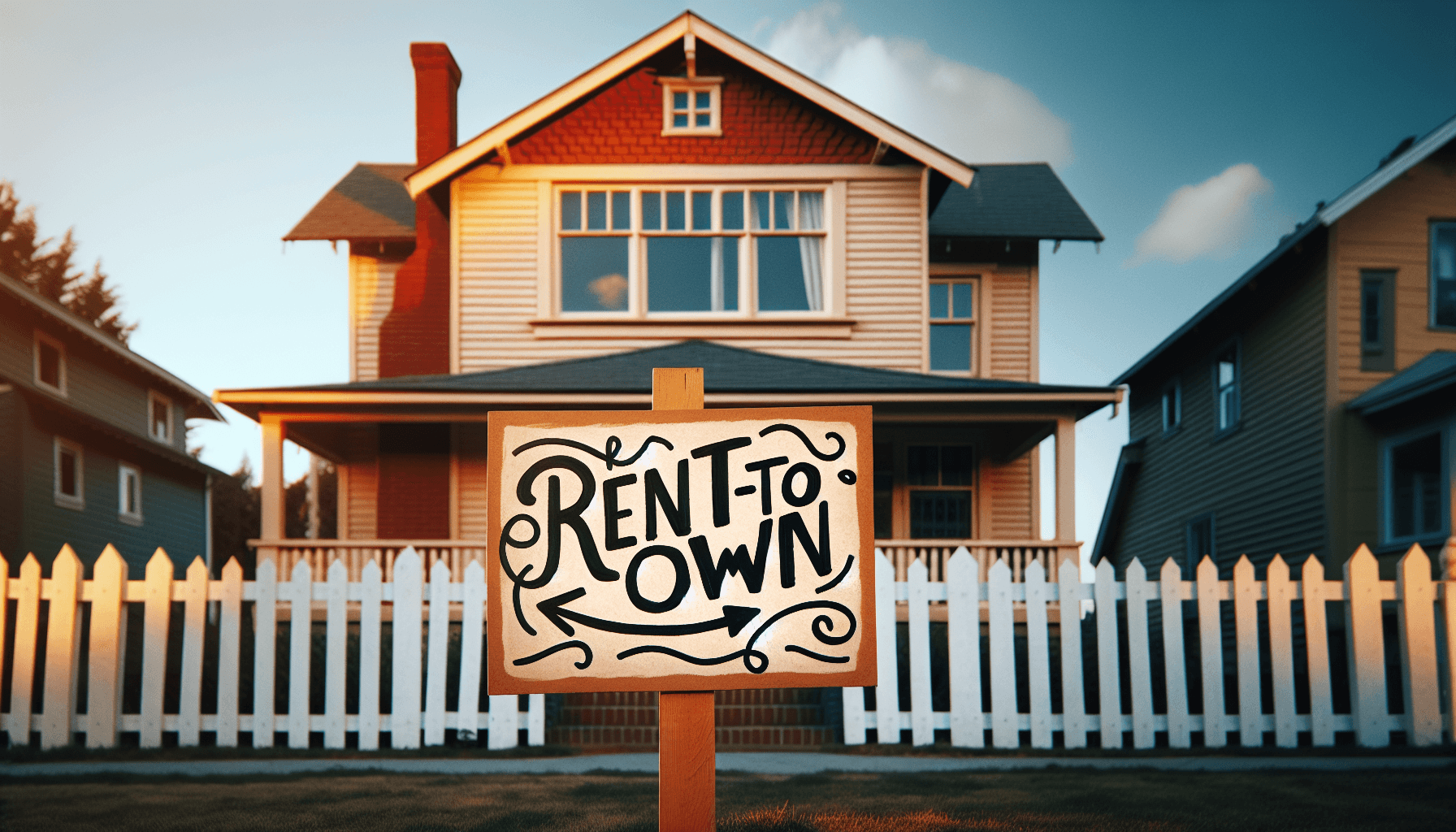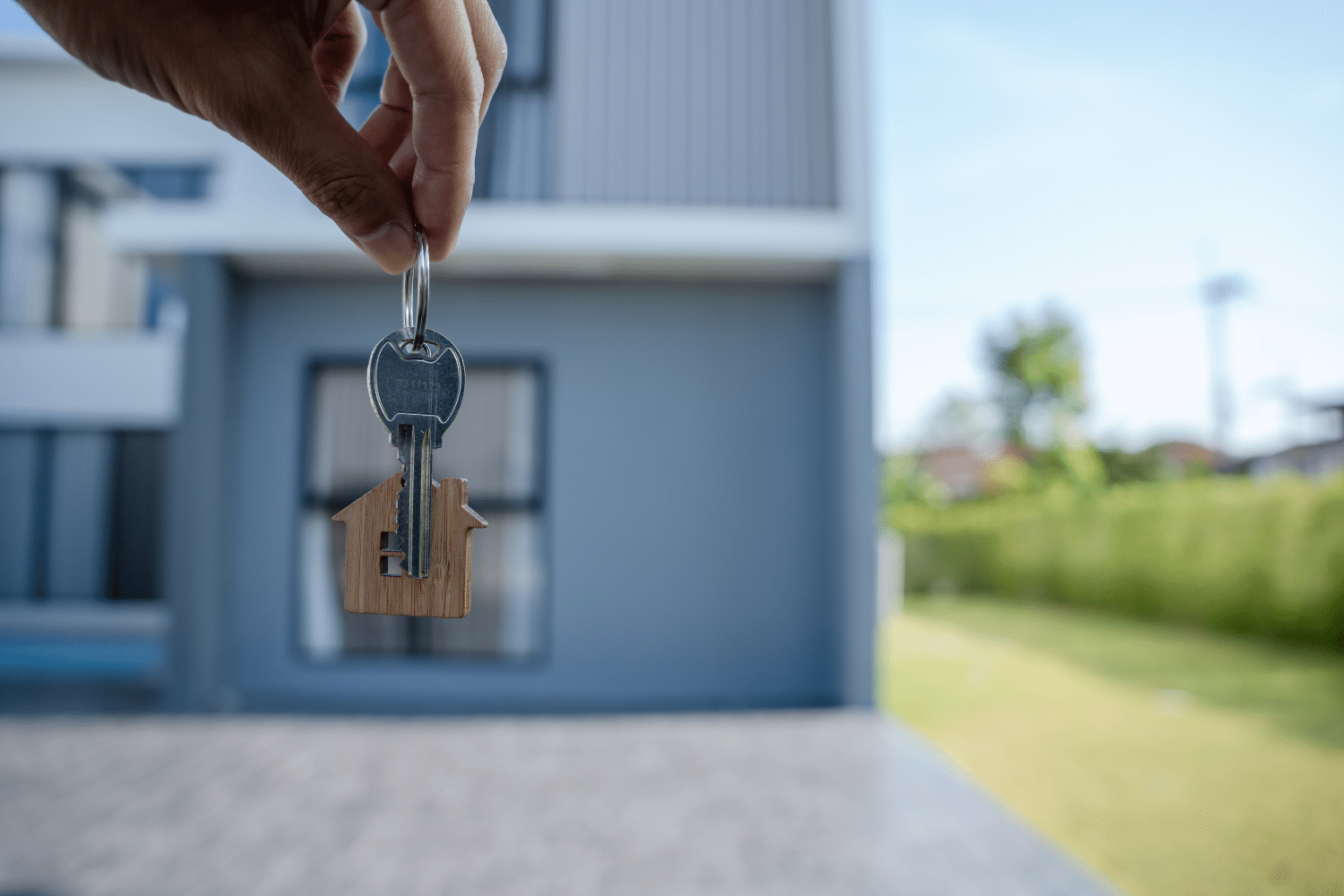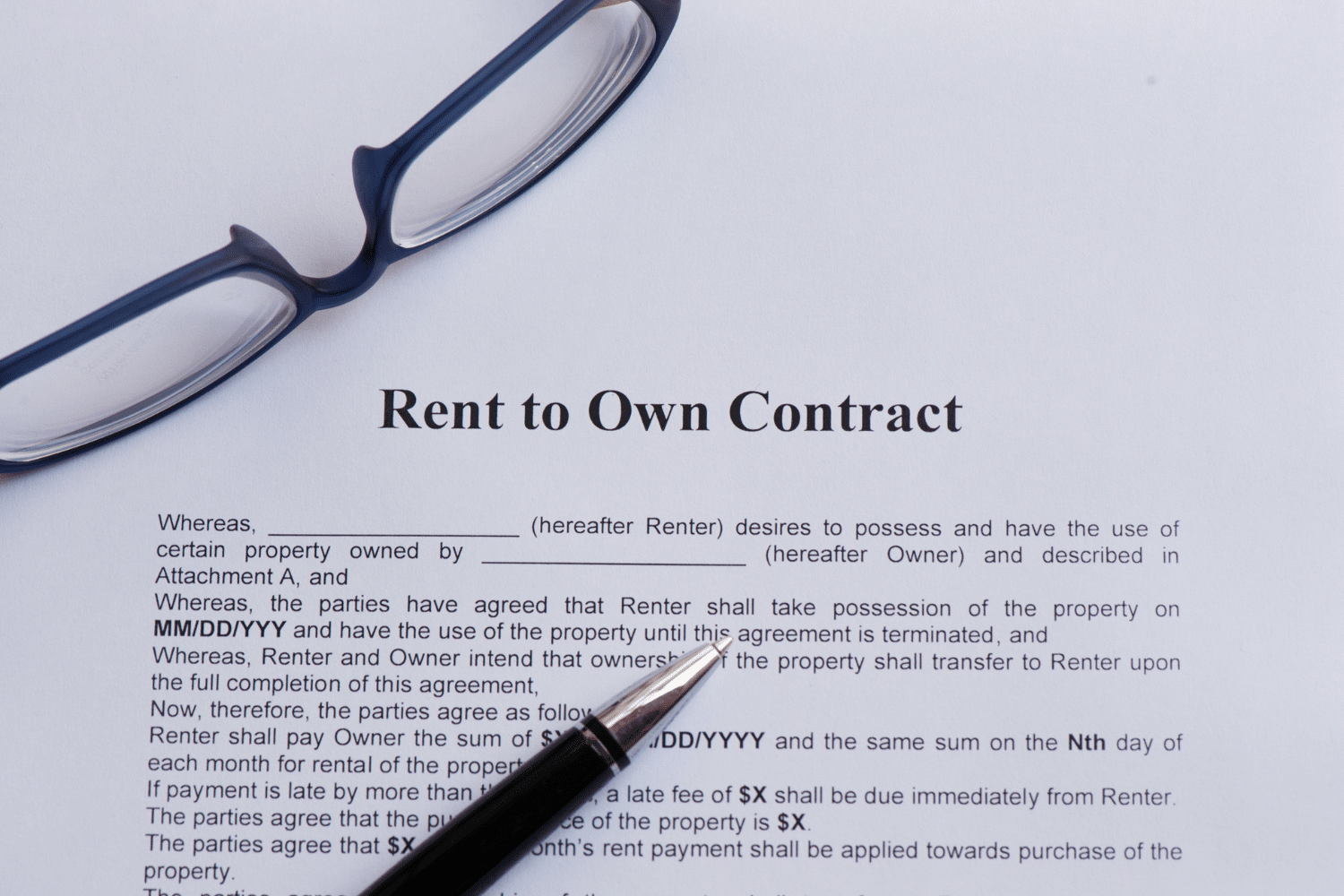Rent to own homes bridge the gap between renting and buying, offering you a chance to eventually own the home you’re leasing. In this detailed exploration, we’ll discuss the rent to own process, examine the critical elements you need to understand, and consider the pros and cons. Whether it’s right for you will depend on your personal and financial circumstances, which we’ll help you navigate and understand the rent to own process.
Key Takeaways On Understanding Rent To Own
- Rent-to-own homes offer a lease with an option to buy, allowing tenants to apply a portion of their rent towards a future down payment, with key details like purchase price and rent credits pre-negotiated.
- Two main contract types exist: lease-option, which gives flexibility to buy, and lease-purchase, which obligates the tenant to purchase at lease end. Understanding each contract type is essential before committing.
- While rent-to-own can provide a path to homeownership for those with less savings or imperfect credit, there are risks involved such as potential loss of investment and higher monthly payments.
Understanding Rent To Own Homes

Rent-to-Own homes, also known as rent to own property, provide a process in which you can lease a property with the potential to purchase it in the future. This arrangement could be an attractive option for people with limited savings or buyers who aren’t quite ready to commit to traditional home-buying. You get to live in the home you might eventually own, all while working towards that goal with each rent payment. In this rent to own work scenario, you’re investing in your future with every payment.
In the realm of real estate, this method works as a unique fusion of home renting and buying. When you pay rent, part of it actually goes towards owning the home eventually. So, you’re not merely a tenant; you’re a potential homeowner, slowly but surely working towards that dream with each monthly payment.
The Rent-to-Own Process
Initiating the rent-to-own process involves a typical lease agreement, enhanced with an additional option to acquire the property. This agreement usually lasts for a period of one to five years. Each month, as you pay your rent, a portion of that payment goes towards the future down payment of the house.
When the lease expires, you get to make a decision. You can choose to buy the property before the lease is up, using the rent credits you’ve accumulated over the years. The purchase price is not random; it’s agreed upon by you and the seller at the start of the agreement or when you decide to buy the home. So, you’re not at the mercy of future fluctuations in the market.
Key Components of Rent-to-Own Agreements
Despite seeming straightforward, a rent-to-own agreement, like any legal contract, comprises several elements. One crucial element is the option fee, which is basically a fee that the potential buyer pays to the seller for the right to buy the home later. This fee is usually non-refundable and typically falls between 1% and 7% of the home’s value.
Another key component is rent credits. These credits accumulate a portion of the rent paid each month. If you decide to buy the home, that accumulated amount can be used as a down payment. The specific amount of rent credits is usually pre-negotiated and often tied to the home’s purchase price. The rent amount and the purchase price are decided by you (the tenant) and the seller together, which makes the entire process more transparent and straightforward.
Types of Rent-to-Own Contracts
Two types of rent-to-own contracts exist: the lease-option and the lease-purchase agreements. These options provide different paths to potential home ownership. Each comes with its own set of obligations and benefits for both the buyer and the seller. The rent to own contract, specifically the lease-option agreement, is a regular lease agreement with an added option to buy the property. It gives more flexibility to the buyer and provides steady revenue for the seller.
On the other hand, the lease-purchase agreement obligates the tenant to buy the property at the end of the lease, solidifying the future transfer of the home. The choice between a lease-option and a lease-purchase agreement comes down to your readiness for commitment. If you want the option to buy without being tied down, a lease-option gives you that flexibility.
But if you’re sure about the sale and ready for homeownership, a lease-purchase agreement locks in the future transfer of the home.
Lease-Option Agreements
The lease-option agreement grants you the opportunity to acquire the property at a predetermined price following a certain timeframe. This agreement type is like renting the property with the option to buy it before the lease is up. The term of this option usually lasts between one to three years, and it comes with an option fee and the right to purchase the property in the future.
The purchase price in lease-option agreements is set in a contract between the landlord and tenant. They agree on a specific price that will be valid at the end of the rental period. This gives you, the tenant, the chance to decide if you’re ready to take on homeownership, either during the rental period or at the end of it.
Lease-Purchase Agreements
Unlike lease-option agreements, lease-purchase agreements require the renter to purchase the property at the end of the lease term. This contract type is a commitment from both sides – the tenant agrees to buy the property, and the owner has to sell it to the tenant as per the contract.
What happens at the end of a lease-purchase agreement? Well, you, the renter, have to buy the property. No second thoughts, no backing out. And this is why it’s crucial to fully understand the terms of the agreement before making any decisions.
Pros and Cons of Rent-to-Own Homes
As with any financial decision, rent-to-own homes present a unique set of advantages and disadvantages. For buyers, these arrangements can provide a chance to build equity and improve credit scores, all while securing a desired property. For sellers, rent-to-own agreements mean a steady flow of income through regular rent payments, no upfront transaction fees, and a larger pool of potential buyers.
However, these agreements also come with potential downsides. Buyers might end up losing their investment if they can’t get financing or qualify for a mortgage when the lease is up. They could lose the option fee, rent credits, and the chance to buy the house if they decide not to go through with the purchase. For sellers, the potential for property damage and a longer sales process could be significant drawbacks.
Benefits for Buyers
Rent-to-own homes can be beneficial for buyers in several ways. For starters, these agreements help buyers build equity gradually. Part of the lease payment goes towards building equity in the home. Also, the buyer might pay a little extra in rent compared to the fair market value, which can help with their down payment once the lease is up, ultimately increasing their equity in the property.
Moreover, rent-to-own homes can improve a buyer’s credit score. During the rental period, buyers can use this arrangement to pay off debt and work on improving their credit, making them more creditworthy for future mortgage applications.
Lastly, these agreements allow buyers to:
- Secure the property they want
- Pay extra on rent, which goes towards their future down payment
- Ensure their claim on the property and protect it from other potential buyers.
Drawbacks for Buyers
While rent-to-own homes can provide several benefits, potential drawbacks need to be considered as well. One major risk for buyers is the possibility of losing their investment if they can’t get financing or qualify for a mortgage when the lease is up. This could mean losing the option fee, rent credits, and the opportunity to buy the house.
Another potential downside is that the monthly payments in rent-to-own contracts could be higher because some of the payment goes towards the eventual purchase price. Tenants might also have to cover fees, maintenance costs, insurance, and property taxes.
Advantages for Sellers
Rent-to-own homes are not just beneficial for buyers; they also offer several advantages for sellers. For starters, they provide a steady flow of income. Sellers receive continuous rental payments, and renters are motivated to stick to their payment schedule because they have the goal of eventually owning the home.
Furthermore, rent-to-own agreements offer the following benefits:
- They appeal to a larger pool of potential buyers as they don’t require immediate financing
- They offer the potential for ownership without upfront purchase
- They provide benefits like steady revenue and no transaction fees for the seller.
Disadvantages for Sellers
However, as with any business transaction, there are potential downsides for sellers as well. Rent-to-own agreements can make the sales process longer. If the buyer doesn’t end up buying within the agreed timeframe, the seller has to wait longer to complete the sale, and they can’t pursue other potential buyers during that time.
Another concern for sellers is the potential for property damage if the tenant doesn’t take care of the home. If the tenant neglects maintenance, it could lead to damage that the seller has to handle later on. If a rent-to-own agreement falls through, the seller might have to handle:
- Legal stuff like evicting a tenant who’s not paying
- Taking care of repairs
- Still paying property taxes even if the tenant isn’t really committed to buying.
Steps to Successfully Navigate Rent-to-Own Homes

While the process of navigating rent-to-own homes may be complex, it can be simplified with the correct steps. The journey starts with:
- Finding the right properties
- Evaluating and negotiating the terms of the agreement
- Conducting due diligence to ensure the property is a sound investment
- Preparing for homeownership
Each step requires careful consideration and planning. From understanding the intricacies of the rent-to-own process to preparing for the potential commitment of homeownership, it’s crucial to be well-informed and prepared.
Finding Rent-to-Own Properties

The initial stride towards a rent-to-own home involves identifying the perfect property. This can be done through a variety of sources. You might choose to work with a real estate agent who is familiar with rent-to-own properties, or you could find listings online on websites like Zillow, Redfin, or Rent-to-Own Labs. It’s important to be cautious when browsing online listings as they can sometimes be unreliable or even fraudulent.
There are also specialized companies that handle rent-to-own properties, like Home Partners of America, Divvy, and Dream America. When you’re checking out a property, you’ll want to look at things like the terms of the agreement (lease length, purchase price, fees), who’s responsible for maintenance and repairs, and the condition of the property.
Evaluating and Negotiating Rent-to-Own Agreements
After identifying a potential property, the subsequent move involves assessing and negotiating the terms of the rent-to-own agreement. It’s crucial to understand the details of the agreement and ensure that they are favorable for you. A real estate attorney can be a valuable resource in this process. They can help ensure all contract details are clear, negotiate for good terms, and make sure both parties are legally protected in the rent-to-own agreement.
You should also be aware of the financial risks involved in rent-to-own agreements. These might include:
- Losing money if you don’t end up buying the property
- Paying higher monthly rent
- Losing your down payments
- Taking on extra fees without a guarantee of financing
The rent price in a rent-to-own agreement is based on the fair market value of the property, so it’s important to ensure you’re getting a fair deal.
Conducting Due Diligence

Following the assessment and negotiation of the rent-to-own agreement, it’s imperative to carry out due diligence. This involves researching the property to uncover any potential issues. This includes:
- Checking for repairs
- Looking into the property’s physical and financial condition
- Conducting a property inspection to uncover any major issues with the property, like structural problems or issues with the electrical and plumbing systems.
Due diligence isn’t just about the property itself; it also involves looking into the seller and the agreement. Some common problems people encounter when checking out rent-to-own homes include:
- disagreements on sales price
- unresolved property tax or lien problems
- not enough research done
- picking the wrong real estate agent
- legal complications such as ongoing lawsuits.
Preparing for Homeownership
Upon gaining confidence in the property and the agreement, the final step is to gear up for homeownership. This involves improving your credit scores, setting aside money for a down payment, and looking into mortgage options. Boosting your credit scores can be achieved by checking your credit reports and scores, paying all your bills on time, lowering your credit card balances, and avoiding opening new accounts.
Saving for a down payment is another crucial step in preparing for homeownership. This is especially important when you’re looking at different mortgage options. When shopping for a mortgage, consider:
- Your credit score and credit report
- Your financial options
- Finding the best rates
- Getting pre-approved
- Figuring out the down payment you can afford
- Gathering all the necessary financial documents
- Understanding closing costs, origination fees, APR, and discount points.
Rent-to-Own Alternatives
Although rent-to-own homes may seem appealing to many, they are not the sole avenue to homeownership. Alternatives to consider include low down payment mortgages and owner financing. Both of these options can help prospective homeowners who might not have the savings for a traditional down payment or who can’t qualify for a traditional mortgage.
Each of these alternatives has its own set of benefits and drawbacks, similar to rent-to-own homes. It’s crucial to consider all your options and make an informed decision that best suits your financial situation and homeownership goals.
Low Down Payment Mortgages
For those unable to afford a substantial upfront payment, low down payment mortgages serve as a viable option. These mortgages allow you to buy a home with a smaller upfront payment, getting you into a home sooner and leaving more money available for other expenses.
To qualify for a low down payment mortgage, you’ll need a good credit score. However, some lenders might be okay with a credit score as low as 500 if you’re willing to make a 10% down payment.
Several banks and financial institutions offer low down payment mortgages including NBKC, Guaranteed Rate, New American Funding, and PenFed Credit Union.
Owner Financing

Owner financing, or seller financing, is another alternative worth considering. In this arrangement, the seller acts as the lender, providing financing to the buyer instead of a traditional mortgage lender. This can be beneficial for buyers who can’t get traditional financing, providing more flexibility in negotiating payment terms, and even making it possible to buy a home without a traditional mortgage.
However, owner financing also comes with its own set of legal considerations. It’s crucial to ensure that the terms of the agreement are fair and comply with state interest rate laws. Additionally, the buyer could lose their right to the property deed if they breach the contract, and they’ll also need to pay the specified taxes to the government agency.
Saving and Improving Credit
Irrespective of your chosen route to homeownership, saving and enhancing your credit score are vital steps. Building a robust credit score will increase your chances of securing a mortgage. It typically takes 3-6 months to build credit from scratch, but improving credit scores further may take a bit more time and responsible use.
When lenders are deciding whether to approve a mortgage application, they look at several factors. These include:
- Your ability to make a down payment
- Your credit history
- Employment history
- Your debt-to-income ratio
- The specific property you’re looking to buy
Summary
So, whether you’re a potential buyer or a seller, rent-to-own homes offer a unique path towards homeownership. They provide a middle ground between renting and owning, allowing both parties to benefit in different ways. Remember, though, like any financial decision, it’s crucial to do your due diligence, understand the terms of the agreement, and decide if it’s the best move for you.
Whether you choose a rent-to-own home or one of its alternatives, the journey to homeownership is a personal and significant one. It’s about finding the right fit for your financial situation and homeownership goals. So, take the time to explore all your options, seek professional advice, and make an informed decision.
Frequently Asked Questions
Yes, rent-to-own agreements are legal in Connecticut, and landlords can offer lease purchase agreements. Make sure the contract is in writing and includes a description of the property.
Yes, in Arizona, you can explore rent-to-own options to help you save money towards a down payment while renting the home you intend to buy. It’s a great way to work towards homeownership while living in the house you hope to own.
The main reason to avoid renting to own is the risk of losing money, including the down payment and non-refundable charges if you decide not to purchase the home, and the potential for higher rent and extra fees. So, considering these factors is crucial before opting for a rent-to-own agreement.
In Florida, rent-to-own contracts must be in writing, signed by both parties, and include all essential terms before being signed. Make sure not to sign any agreement with blank spaces and request a copy of the signed contract for your records.
A rent-to-own home is an arrangement where you can rent a property for a period and have the option to purchase it at a predetermined price. Part of the extra rent paid each month is put towards a down payment on the property.




